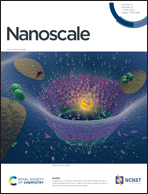An ultraweak mechanical stimuli actuated single electrode triboelectric nanogenerator with high energy conversion efficiency†
Abstract
Triboelectric nanogenerator (TENG) as a new energy harvester has attracted significant attention due to its excellent output performance and high energy conversion efficiency at low-frequency, small-amplitude and weak-force compared with a traditional electromagnetic generator. Here, an ultraweak mechanical stimuli actuated single electrode triboelectric nanogenerator (UMA-TENG) has been studied with an atomic force microscope. The electrical output and force curve of UMA-TENG were studied at first, as well as the maximum output performance and highest energy conversion efficiency. Then the influence of the driving frequency, separation distance and motion amplitude was investigated, respectively. Moreover, by introducing an external switch to reach a cycle of maximized energy output, the maximum energy conversion efficiency of the UMA-TENG was up to 73.6% with an input mechanical energy of 48 pJ. This work demonstrates that the TENG shows excellent performance in ultraweak mechanical stimuli and could broaden the applications of the TENG in sensors, actuators, micro-robotics, micro-electro-mechanical-systems, and wearable electronics.



 Please wait while we load your content...
Please wait while we load your content...